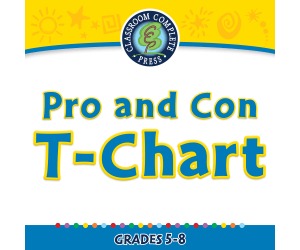2,826 products added recently
T Chart
A T Chart is a graphic organizer that divides information into two columns, allowing students to compare and contrast topics, list pros and cons, or separate facts and opinions. This tool aids in organizing thoughts and can be used across subjects. Incorporate T charts to enhance critical thinking and analysis skills.
How to Write An Essay: Pro and Con T-Chart - FLASH-MAC
ELA, Writing, Common Core, Grade 5, 6, 7, 8, Charts, Teacher Tools
The How to Write An Essay: Pro and Con T- Chart -FLASH-MAC An innovative teaching resource that aids learners in honing their essay writing skills. This tool is particularly beneficial for teachers and home educators, designed to enable students to conduct a comprehensive analysis of the positives and negatives of a subject. Educational Challenge The software imparts an educational challenge, requiring students to delve into differing views regarding the question: 'Should school be two hours longer each day?'. Students are urged to organize arguments from a pre-set list into separate sections labelled as pros and cons within an illustrative T- chart graphic organizer. Alignment with Educational Standards Created specifically for Grade 5 - Grade 8 students specializing in Language Arts under the Writing domain. Consistent with Common Core State Standards, thus guaranteeing uniformity across curricula. Synchronizes smoothly with Blooms Taxonomy principles promoting critical thinking skills. User-friendly Design for Mac Systems This teaching tool showcases a simple-to-use interface suitable for Mac platforms. Teachers can easily incorporate it during full class activities or smaller group tasks where students derive value from sharing ideas. Besides serving as an engaging classroom aid, it can also be deployed as homework tasks pushing pupils towards considering both sides before sharing their thoughts during class discussions. In Conclusion, The 'How to write An Essay: Pro and Con T- Chart - FLASH MAC' directs students towards developing balanced informed opinions while building superior essay writing capabilities. Offering diverse methods ranging from team brainstorming sessions down to individual assignments allows tailoring lessons according respective student requirements or lesson plan structures; transforming it into an engaging educational tool providing rewarding learning experiences.
Author Classroom Complete Press
Tags Software (Mac)
Material vs Non-Material Culture with Acadian Culture Reading Passage and T-Charts
Social Studies, ELA, History, History: Canada, Reading, Reading Comprehension, Science, Earth and Environmental Sciences, Life Sciences, Nature & Plants, Grade 5, 6, 7, 8, Charts, Teacher Tools
This middle school social studies lesson has three parts to help teach your students the difference between material and non-material culture. 1) An introduction to the concept of material vs. non-material culture 2) A one-page reading about Acadian culture. Students will sort the parts of this culture in a T-chart. 3) A second T-chart for students to sort the material and non-material aspects of their own culture. How to Use: Teach your students the difference between material and non-material culture. Culture is the set of values, ideas, traditions, and objects that a group passes from one generation to the next. It can be divided into two categories: Material: physical objects, books, art, structures, clothing, technology Non-Material: ideas/values/things that can’t be seen, language, religion, customs, rules, education, government Brainstorm aspects of culture on the board and sort them into the two categories. Students read the one-page passage about Acadian culture and sort the parts that are material and non-material onto their T-chart. They could do this independently or in small groups. Share the results as a class. Notice if any parts of culture are hard to categorize in this way. Then students think about their own culture and sort aspects of it into material and non-material culture. This could become the basis for a paragraph or short essay assignment. Grades to Use With: This assignment is designed for students in the middle grades (5-8) or high school special education classrooms. Standards: CCSSW.5.8 Recall relevant information from experiences or gather relevant information from print and digital sources; summarize or paraphrase information in notes and finished work, and provide a list of sources. If you like this product, check out my store for other middle grades science, math, and language arts assignments! Grace Under Pressure
Author Grace Under Pressure
Tags Culture, Social Studies, Acadian, Reading Passage, T-chart, Material Culture, Non-material Culture, Traditions, Canadian History, Maritimes, Non Material Vs Material Culture, What Is The Difference Between Material And Non-material Culture?, Material Vs Non Material, Difference Between Material And Non-material Culture, Material And Non Material Culture, Material Culture Vs Non Material Culture



